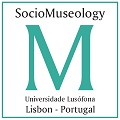Valorização e Musealização do Património no Meio Urbano: Caso das Pinturas Murais Públicas da Cidade de Lisboa
Resumen
Importa compreender a função da museologia como um processo de transmissão de
conhecimentos, heranças e memórias coletivas, premiando a comunicação. Nos dias de hoje,
em plena globalização e com as novas tecnologias em expansão, coloca-se o desafio de
adaptar as políticas e as práticas museológicas numa museologia interdisciplinar,
compreendendo as valências das novas tecnologias de informação (TIC) a favor da
Sociomuseologia. Neste artigo, procura-se relacionar a museologia com o património mural, tendo por base a identificação prévia dos locais de pintura mural, bem como dos edifícios onde estas estão
inseridas. Pretende-se analisar a sua história, os seus autores e arquitetos, encomendadores, e
realizar um enquadramento sociocultural, que prevaleceu na Cidade de Lisboa (Portugal)
durante o Estado Novo, com particular relevância histórica e museológica.
Proporcionar, um conhecimento pela arte mural, compreendendo o seu papel na sociedade de
hoje e contextualizando-a à época em que foi executada. Interpretar a simbologia e a
importância sociocultural que os murais tiveram durante o período do Estado Novo e que
adquirem ainda hoje. Analisar o significado ideológico dos espaços públicos, percebendo o
processo de espaço “sacralizado” ao “dessacralizado”. Importa então, vir a responder às seguintes perguntas de investigação:
• Qual a importância de musealizar o património mural da Cidade de Lisboa?
• Que simbologias transportam as referidas pinturas murais?
• Qual o significado ideológico dos Espaços Públicos?
• Que vantagens trazem as novas tecnologias para a Museologia?
Palavras-chaves: Museologia e comunicação; Património; Pinturas Murais; Simbologia;
Espaços Públicos.
Descargas
Los autores conservan los derechos de autor y otorgan a la revista el derecho a la primera publicación, con el trabajo licenciado simultáneamente bajo la Licencia Creative Commons Attribution License que permite compartir el trabajo con reconocimiento de autoría y publicación inicial en esta revista.













